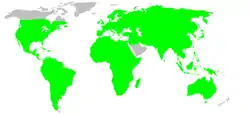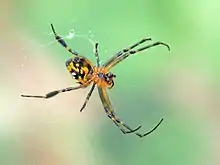| Long-jawed orb-weavers Temporal range: | |
|---|---|
.jpg.webp) | |
| Metellina mengei | |
_female.jpg.webp) | |
| Tetragnatha montana, female | |
| Scientific classification | |
| Domain: | Eukaryota |
| Kingdom: | Animalia |
| Phylum: | Arthropoda |
| Subphylum: | Chelicerata |
| Class: | Arachnida |
| Order: | Araneae |
| Infraorder: | Araneomorphae |
| Family: | Tetragnathidae Menge, 1866 |
| Diversity | |
| 50 genera, 989 species | |
 | |
Long-jawed orb weavers or long jawed spiders (Tetragnathidae) are a family of araneomorph spiders first described by Anton Menge in 1866.[1] They have elongated bodies, legs, and chelicerae, and build small orb webs with an open hub with few, wide-set radii and spirals with no signal line or retreat. Some species are often found in long vegetation near water.
Systematics
As of March 2021, the World Spider Catalog accepts the following extant genera:[2]
- Alcimosphenus Simon, 1895 — Caribbean
- Allende Álvarez-Padilla, 2007 — Chile, Argentina
- Antillognatha Bryant, 1945 — Hispaniola
- Atelidea Simon, 1895 — Sri Lanka
- Azilia Keyserling, 1881 — United States, Panama, South America, Caribbean
- Chrysometa Simon, 1894 — South America, Central America, Mexico, Caribbean
- Cyrtognatha Keyserling, 1881 — South America, Central America, Caribbean, Mexico
- Dianleucauge Song & Zhu, 1994 — China
- Diphya Nicolet, 1849 — Asia, South America, Africa
- Dolichognatha O. Pickard-Cambridge, 1869 — Asia, Africa, South America, Oceania, United States, Panama
- Doryonychus Simon, 1900 — Hawaii
- Dyschiriognatha Simon, 1893 — Indonesia, Brazil, Samoa
- Glenognatha Simon, 1887 — Africa, South America, Asia, North America, Central America, Caribbean
- Guizygiella Zhu, Kim & Song, 1997 — Asia
- Harlanethis Álvarez-Padilla, Kallal & Hormiga, 2020 — Australia (Queensland)
- Hispanognatha Bryant, 1945 — Hispaniola
- Homalometa Simon, 1898 — Central America, Cuba, Mexico, Brazil
- Iamarra Álvarez-Padilla, Kallal & Hormiga, 2020 — Australia (Queensland)
- Leucauge White, 1841 (including Opas) — Africa, North America, Asia, Oceania, South America, Central America, Caribbean
- Mecynometa Simon, 1894 — Africa, Guatemala, Brazil
- Mesida Kulczyński, 1911 — Oceania, Asia, Africa
- Meta C. L. Koch, 1836 — Asia, North America, Tanzania, Oceania, Cuba
- Metabus O. Pickard-Cambridge, 1899 — Mexico, Guatemala, Ecuador, Dominican Republic
- Metellina Chamberlin & Ivie, 1941 — Africa, Asia, Canada
- Metleucauge Levi, 1980 — Asia, United States
- Mitoscelis Thorell, 1890 — Indonesia
- Mollemeta Álvarez-Padilla, 2007 — Chile
- Nanningia Zhu, Kim & Song, 1997
- Nanometa Simon, 1908 — Australia
- Neoprolochus Reimoser, 1927 — Indonesia
- Okileucauge Tanikawa, 2001 — China, Japan
- Opadometa Archer, 1951 — Asia, Papua New Guinea
- Orsinome Thorell, 1890 — Asia, Oceania, Madagascar
- Pachygnatha Sundevall, 1823 — Africa, Asia, North America, Cuba, Europe
- Parameta Simon, 1895 — Ethiopia, Somalia, Sierra Leone
- Parazilia Lessert, 1938 — Congo
- Pholcipes Schmidt & Krause, 1993 — Comoros
- Pickardinella Archer, 1951 — Mexico
- Pinkfloydia Dimitrov & Hormiga, 2011 — Australia
- Sancus Tullgren, 1910 — Kenya, Tanzania
- Schenkeliella Strand, 1934 — Sri Lanka
- Taraire Álvarez-Padilla, Kallal & Hormiga, 2020 — New Zealand
- Tawhai Álvarez-Padilla, Kallal & Hormiga, 2020 — New Zealand
- Tetragnatha Latreille, 1804 — Asia, South America, Oceania, Africa, North America, Caribbean, Central America, Europe
- Timonoe Thorell, 1898 — Myanmar
- Tylorida Simon, 1894 — Asia, Africa, Oceania
- Wolongia Zhu, Kim & Song, 1997 — China
- Zhinu Kallal & Hormiga, 2018 — Taiwan, Korea, Japan
- Zygiometella Wunderlich, 1995 — Israel
Fossil genera
Several extinct, fossil genera have been described:[3]
- †Anameta Wunderlich, 2004 (Palaeogene, Bitterfield and Baltic amber)
- †Balticgnatha Wunderlich, 2004 (Palaeogene, Baltic amber)
- †Corneometa Wunderlich, 2004 (Palaeogene, Baltic amber)
- †Eometa Petrunkevitch, 1958 (Palaeogene, Baltic amber)
- †Huergnina Selden & Penney, 2003 (Cretaceous, Las Hoyas, Spain)
- †Macryphantes Selden, 1990 (Cretaceous)
- †Palaeometa Petrunkevitch, 1922 (Palaeogene, Florissant)
- †Palaeopachygnatha Petrunkevitch, 1922 (Palaeogene, Florissant)
- †Priscometa Petrunkevitch, 1958 (Palaeogene, Baltic amber)
- †Samlandicmeta Wunderlich, 2012 (Palaeogene, Baltic amber)
Formerly placed here
- Deliochus Simon, 1894 – now in Araneidae
- Eryciniolia Strand, 1912 – now a synonym of Nanometa
- Menosira Chikuni, 1955 – now a synonym of Metellina
- Nediphya Marusik & Omelko, 2017 – now a synonym of Nanometa
- Phonognatha Simon, 1894 – now in Araneidae
- Prolochus Thorell, 1895 – see Dolichognatha
See also
A few spiders in this family include:
References
- ↑ Menge, Anton (1866). "Preussische Spinnen. Erste Abtheilung". Schriften der Naturforschenden Gesellschaft in Danzig (N.F.). 1.
- ↑ "Family: Tetragnathidae Menge, 1866". World Spider Catalog. Natural History Museum Bern. Retrieved 2021-03-06.
- ↑ Dunlop, J. A., Penney, D. & Jekel, D. 2018. A summary list of fossil spiders and their relatives. In World Spider Catalog. Natural History Museum Bern, online at http://wsc.nmbe.ch, version 19.0, accessed on 7 October 2018.
External links
Wikimedia Commons has media related to Tetragnathidae.
Wikispecies has information related to Tetragnathidae.
- Tree of Life Tetragnathidae
- Tatragnatha sp. Large format diagnostic photographs and information
- Reference Photos: Tetragnatha laboriosa
- Venusta Orchard Spider - Family Tetragnathidae
- Pictures of Tetragnatha sp. (free for noncommercial use)
This article is issued from Wikipedia. The text is licensed under Creative Commons - Attribution - Sharealike. Additional terms may apply for the media files.
